Yes, ZZ plants (Zamioculcas zamiifolia) are toxic to cats due to their calcium oxalate crystals, which can cause serious health issues if ingested. Your cat may experience immediate symptoms including drooling, vomiting, difficulty breathing, and behavioral changes. If you suspect your cat has consumed any part of a ZZ plant, you'll need to act quickly by rinsing their mouth with water and contacting your veterinarian. Don't induce vomiting without professional guidance. To protect your pet, keep ZZ plants in inaccessible areas or consider pet-safe alternatives like catnip or wheat grass. Understanding the full scope of risks and prevention strategies can help guarantee your cat's safety.
TLDR
- ZZ plants are toxic to cats due to calcium oxalate crystals, which can cause severe mouth and digestive system damage.
- Common symptoms of ZZ plant poisoning include drooling, vomiting, difficulty breathing, and behavioral changes within hours of ingestion.
- Remove cats from plant access immediately and contact a veterinarian if ingestion occurs, avoiding self-induced vomiting.
- Long-term exposure can lead to kidney problems and digestive complications, requiring regular veterinary monitoring during recovery.
- Keep ZZ plants in inaccessible areas or consider pet-friendly alternatives like catnip to ensure cat safety.
Understanding the ZZ Plant
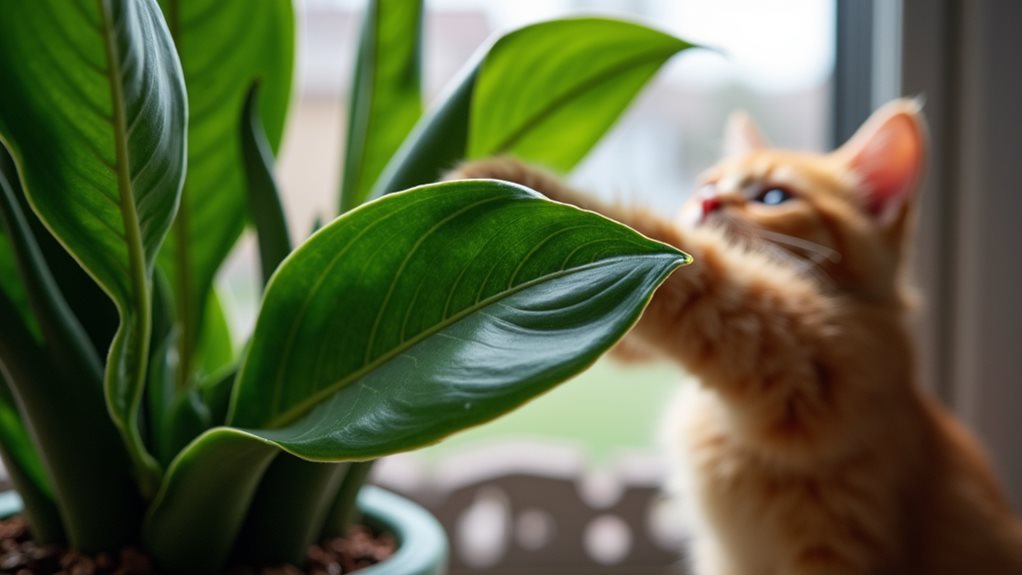
The ZZ plant (Zamioculcas zamiifolia) is a popular tropical houseplant that's captured the attention of indoor gardeners worldwide. Native to Eastern Africa, this hardy perennial can grow up to 3 feet tall indoors, featuring glossy green leaves that create a tapered, palm-like appearance. Also known as the Zanzibar Gem, this plant has earned multiple nicknames due to its striking appearance. You'll find it's particularly adaptable, thriving even in low-light conditions that would challenge other houseplants. This resilience is akin to the essential gardening tools that support a gardener's success in various conditions.
Signs of Cat Poisoning
When your cat ingests parts of a ZZ plant, symptoms typically appear within a few hours and can manifest in several ways. You'll notice gastrointestinal signs like drooling, vomiting, or diarrhea first. Early recognition of these symptoms and seeking veterinary care immediately can significantly improve your cat's chances of recovery. Additionally, ingesting toxic plants can lead to serious health risks that require prompt attention. Watch for neurological symptoms such as hiding, tremors, or incoordination. Your cat may also show respiratory issues, including difficulty breathing and coughing, along with general signs of lethargy and depression.
Why ZZ Plants Harm Cats
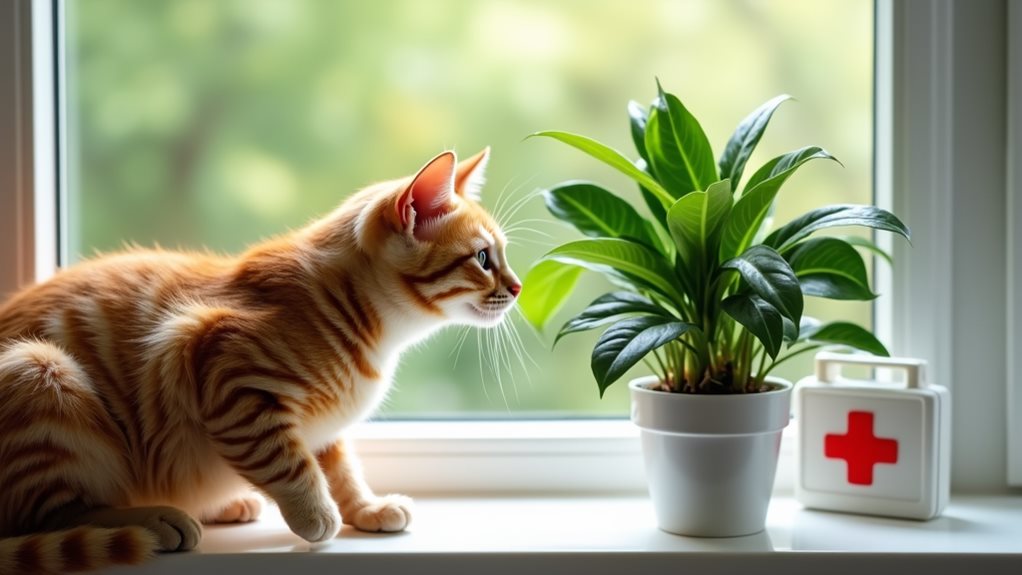
Understanding why ZZ plants harm cats starts with their natural defense mechanism: calcium oxalate crystals.
These microscopic, needle-sharp crystals are found throughout the plant's leaves, stems, and roots. Roof rats are also known to have similar defensive adaptations in their environment, using their agility to evade predators. When your cat bites or chews any part of the ZZ plant, these insoluble crystals immediately penetrate soft tissues, causing cell damage and triggering painful irritation in their mouth and digestive system. While the plant can reach 2 to 3 feet tall, even small amounts can cause significant discomfort to cats.
Emergency Response Steps
Swift action becomes essential if your cat ingests any part of a ZZ plant.
Remove remaining plant material from your cat's mouth and rinse it gently with water.
Don't induce vomiting without veterinary guidance, but monitor your pet closely for signs of distress. Harmful bacteria can enter your cat's system if the plant is contaminated.
The toxic calcium oxalate crystals in ZZ plants can cause immediate irritation and discomfort.
Contact your vet immediately if you notice excessive drooling, difficulty swallowing, or respiratory issues, providing details about the ingestion time and amount.
Keeping Your Cat Safe
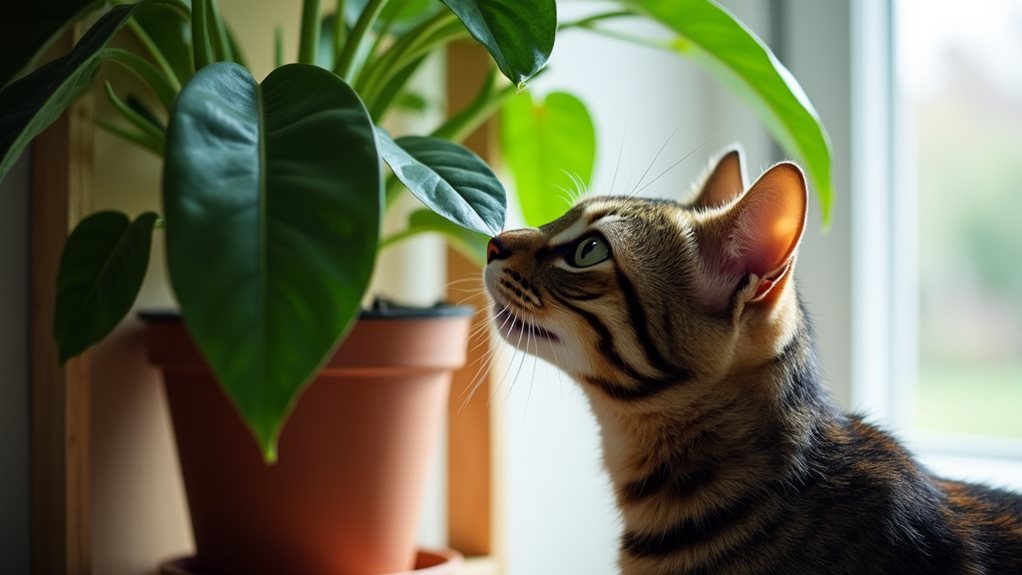
To protect your cat from ZZ plant toxicity, you'll want to investigate pet-safe alternatives like spider plants and Boston ferns that can beautify your home without posing health risks.
Strategic plant placement is essential, so position your ZZ plants on high shelves, in hanging baskets, or behind closed doors where your curious feline can't access them.
You can also train your cat to avoid plants naturally by providing engaging alternatives like cat grass, interactive toys, and scratching posts that redirect their attention away from potentially harmful houseplants.
#
Pet-Safe Plant Alternatives
When choosing alternatives to the ZZ plant, numerous pet-safe options can modify your living space while keeping your feline friend protected.
Consider low-maintenance choices like the Russian Sage or Parlor Palm for drought resistance, or opt for indoor-friendly varieties such as African Violets and Spider Plants.
These alternatives offer both aesthetic appeal and safety, with many providing additional benefits like air purification.
Secure Plant Placement Tips
Since ZZ plants pose a toxicity risk to cats, proper placement and protective measures are crucial for maintaining a safe environment.
Position your ZZ plants on high shelves that are completely inaccessible to your cat's jumping range, and guarantee there's no nearby furniture they could use as a launch pad.
Consider using hanging planters or placing the plants in well-secured corners, away from your cat's reach.
Train Cat Away Naturally
Beyond physical barriers, training your cat to stay away from ZZ plants offers another layer of protection.
You can use positive reinforcement techniques combined with clicker training to redirect your cat's attention. Establish clear hand signals and voice commands, while rewarding your pet when they avoid the plant.
Consistently practice desensitization and counter-conditioning to help your cat develop new, safer behaviors.
Long-Term Health Risks
While ZZ plant poisoning might seem minor at first, your cat's long-term kidney health could be at serious risk from repeated exposure to calcium oxalate crystals.
The plant's toxic compounds can gradually build up in your cat's system, potentially leading to chronic kidney disease and an increased likelihood of kidney stones.
You'll need to watch for hidden damage to your cat's digestive system as well, since frequent contact with the plant's sharp crystals can cause lasting harm to the throat and intestinal tract.
Kidney Damage Potential
The long-term risk of kidney damage poses one of the most serious threats to cats who ingest ZZ plants.
When your cat consumes ZZ plant material, calcium oxalate crystals can accumulate in their kidneys, leading to chronic kidney disease.
These insoluble crystals don't pass easily through your cat's system, and repeated exposure can result in severe complications, including reduced kidney function and potential organ failure.
Hidden Digestive System Effects
Hidden digestive system effects lurk beneath the surface when cats ingest ZZ plants, often manifesting long after initial exposure.
Your cat's digestive tract can suffer lasting damage from the sharp calcium oxalate crystals, while repeated exposure may heighten their sensitivity to future incidents.
You'll need to watch for chronic issues like nutritional deficiencies that can develop from prolonged appetite loss.
## Pet-Safe Plant Alternatives
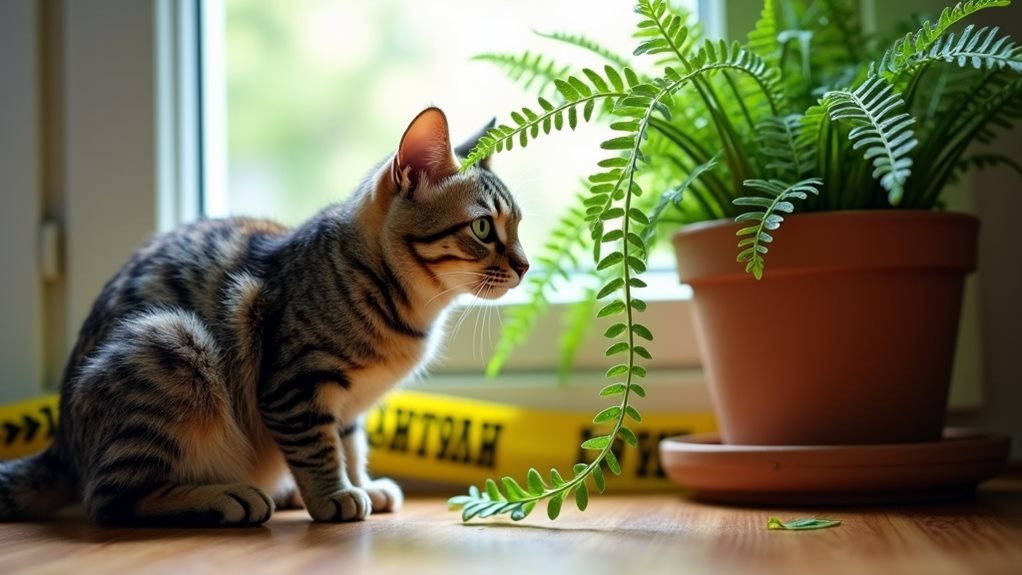
Fortunately, numerous beautiful and low-maintenance plants can safely replace the ZZ plant in your home without risking your cat's health.
Consider options like the Fatsia Japonica, which offers lush green leaves similar to popular toxic plants, or the graceful Ponytail Palm.
You'll also find pet-safe alternatives in the Spider Plant, Boston Fern, and various Peperomia varieties, all offering distinctive foliage and easy care.
Treatment Options
If your cat has ingested a ZZ plant, you'll need to seek immediate veterinary care while following basic first aid steps like rinsing your cat's mouth with water and providing fresh drinking water.
Your veterinarian may recommend specific treatments, including anti-inflammatory medications, fluid therapy, or supportive care depending on the severity of symptoms.
To support your cat's recovery, you'll need to maintain a calm environment, monitor their eating and drinking habits, and follow any prescribed medication schedules while keeping them away from all toxic plants.
Veterinary Care Guidelines
Professional veterinary care is crucial when a cat shows signs of ZZ plant poisoning.
Contact your vet immediately and provide details about the amount ingested, as they'll determine if vomiting should be induced.
They'll likely administer activated charcoal to absorb toxins, conduct diagnostic tests, and provide supportive care like fluid therapy while monitoring your cat's essential signs throughout treatment.
Home First Aid Steps
Quick action with home first aid can help minimize the effects of ZZ plant toxicity in cats while you seek veterinary care.
Remove any plant material from your cat's mouth, gently wipe the area with a wet cloth, and provide fresh water to help dilute toxins.
Monitor your cat closely for symptoms like drooling, vomiting, or skin irritation, while keeping emergency contact numbers ready.
Recovery Support Essentials
A cat's recovery from ZZ plant toxicity requires a thorough treatment approach under veterinary supervision.
You'll need to follow your vet's guidance for activated charcoal administration to absorb toxins, while fluid therapy helps maintain hydration.
They'll monitor your cat's health indicators and may provide medications for symptom management.
Long-term observation is essential, and you should schedule regular check-ups to track your pet's recovery progress.
Prevention Tips for Cat Owners
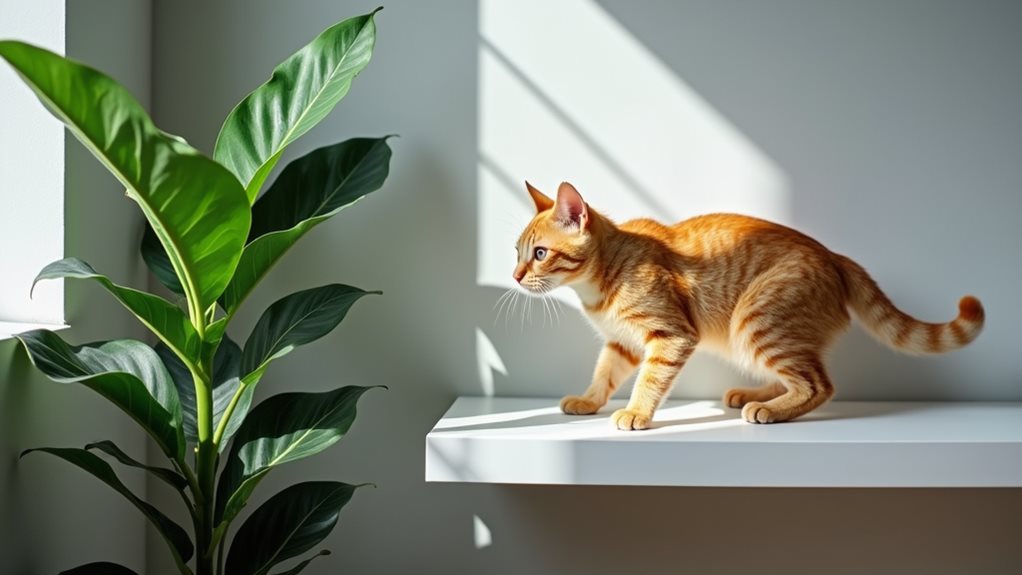
Safety-conscious cat owners have several effective strategies to protect their pets from ZZ plant toxicity.
You'll want to place ZZ plants in high or inaccessible locations, using hanging pots or dedicated plant rooms where cats can't reach them.
Consider offering pet-safe alternatives like catnip or wheat grass, and use deterrents such as citrus peels or vinegar spray around plant areas.
Safe Plant Handling Methods
Proper handling of ZZ plants requires specific precautions to protect both you and your cats from toxic exposure.
Always wear protective gloves when handling or maintaining your plant, and avoid direct contact with leaves and stems.
After any interaction with your ZZ plant, wash your hands thoroughly.
During cleaning or watering, be careful not to break leaves, as this can release harmful sap.
And Finally
You've learned that ZZ plants pose real risks to your feline friends, but with proper precautions, you can create a safe environment for your pets. Remember to keep these plants out of reach, recognize poisoning symptoms quickly, and have your vet's contact information readily available. Consider replacing ZZ plants with pet-safe alternatives, and always research new houseplants before bringing them into your cat-friendly home.